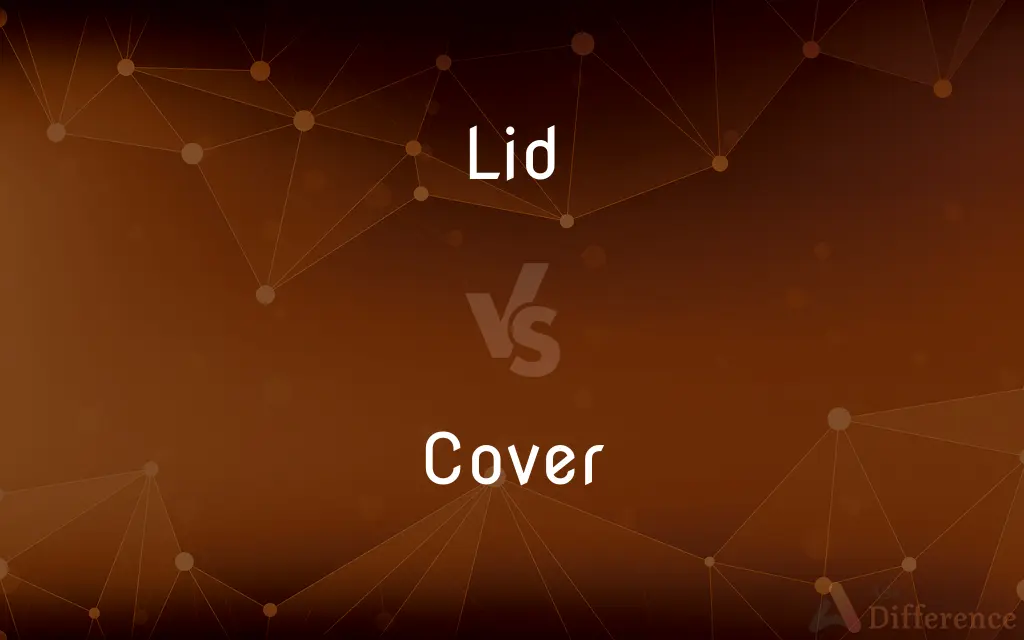Lid vs. Cover — What's the Difference?
By Fiza Rafique & Urooj Arif — Updated on March 6, 2024
A lid is designed to fit securely on top of a container, while a cover can be any protective layer that lies over or wraps around an object.

Difference Between Lid and Cover
Table of Contents
ADVERTISEMENT
Key Differences
Lids are typically designed as part of a container's design to form a seal, preventing spillage and preserving the contents. They are often specific in shape and size to match the container they are meant to close, such as pot lids, jar lids, or the lids on plastic storage containers. On the other hand, covers have a broader application and can refer to anything that is used to protect, hide, or shield an object. This can include things like a book cover, a furniture cover, or a cover for a car. Covers do not necessarily need to fit as precisely as lids and can be used in a more versatile manner.
Lids often have a functional role in creating an airtight or watertight seal, which is crucial for the preservation of food or maintaining the temperature of liquids. In contrast, covers are primarily used for protection against external elements, such as dust, sunlight, or scratches, and may not provide a seal. For example, a grill cover protects the grill from weather conditions but does not seal it from air or moisture.
The material of lids is usually determined by the container they are designed to seal. Common materials include plastic, metal, glass, or wood. Covers, however, can be made from a wider range of materials depending on their purpose, including fabric, plastic, metal, or paper.
In terms of design, lids are often engineered with specific features to enhance their sealing capabilities, such as screw tops, snap fits, or rubber gaskets. Covers, however, might be designed with aesthetics or functionality in mind, such as ease of use, durability, or appearance, without the need for sealing features.
While both lids and covers serve the purpose of protection, lids are more closely associated with the containment and preservation of the contents within a container. Covers, while also protective, offer a broader range of uses that extend beyond sealing, including decoration, concealment, and safeguarding against environmental factors.
ADVERTISEMENT
Comparison Chart
Definition
A removable or hinged top for a container.
Any protective layer over or around an object.
Purpose
To seal and secure the contents of a container.
To protect, hide, or shield an object.
Specificity
Designed to fit a specific container.
Can be used more broadly and with various objects.
Seal
Often creates an airtight or watertight seal.
May not provide a seal.
Materials
Plastic, metal, glass, wood.
Fabric, plastic, metal, paper, etc.
Design Features
Screw tops, snap fits, rubber gaskets for sealing.
Designed for functionality, durability, aesthetics.
Compare with Definitions
Lid
Often creates a seal to preserve contents.
The vacuum seal lid keeps the coffee beans fresh for longer.
Cover
Can be used for a wide range of items.
She put a cover over the piano to prevent dust accumulation.
Lid
Specific to the container it fits.
The pot lid perfectly matched its diameter, ensuring a good seal.
Cover
Does not necessarily seal or fit precisely.
The cover for the grill was large and draped over it loosely.
Lid
Can be hinged or detachable.
The kettle's hinged lid makes it easy to fill.
Cover
Made from various materials for different purposes.
The book's durable cover kept it in good condition.
Lid
Used for containment and preservation.
The lid on the thermal mug kept the tea warm throughout the morning.
Cover
A protective layer or piece used to wrap or shield an object.
The waterproof cover protected the bike from rain.
Lid
A removable top for a container, designed to cover its opening.
She struggled to remove the tight lid from the jar.
Cover
Serves purposes beyond sealing, including decoration.
The decorative cover on the couch added to the room's aesthetic.
Lid
A lid, also known as a cover, is part of a container, and serves as the closure or seal, usually one that completely closes the object. Lids can be placed on small containers such as tubs as well as larger lids for open-head pails and drums.
Cover
Play a higher card than the one previously played;
Smith covered again
Lid
A removable or hinged cover for the top of a container
A dustbin lid
Cover
Sit on (eggs);
Birds brood
The female covers the eggs
Lid
A removable or hinged cover for a hollow receptacle or box.
Cover
To place something upon or over, so as to protect or conceal
Covered the boat with a tarp.
Covered the photo with his hand.
Lid
Either of two folds of skin that can be moved to cover or open the eye;
His lids would stay open no longer
Cover
To overlay or spread with something
Cover the potatoes with gravy.
Lid
A movable top or cover (hinged or separate) for closing the opening of a container
Cover
To put a cover or covering on
Covered jar with a lid.
Cover
To lie over or adhere to so as to protect or conceal
The rug covers the gouges in the floor. Paint covers the stains on the ceiling.
Cover
To spread over a surface to protect or conceal something
A paint that covers well.
Cover
Shelter or protection
The sheep seek cover in the cave when it snows.
Cover
Form a cover over;
The grass covered the grave
Cover
Protect or defend (a position in a game);
He covered left field
Cover
Put something on top of something else;
Cover the meat with a lot of gravy
Cover
Clothe, as if for protection from the elements;
Cover your head!
Common Curiosities
Can a cover also serve as a lid?
In some cases, a cover can serve as a lid if it fits securely over the opening of a container, but this is not its primary function.
How do I choose the right cover for an item?
Choose a cover based on the item's dimensions, the level of protection needed, and the specific conditions it needs protection from (e.g., water, dust).
Why might some containers have both a lid and a cover?
Some containers might use a lid for sealing and a cover for additional protection, insulation, or aesthetic purposes.
Can a lid be considered a type of cover?
Yes, a lid can be considered a specific type of cover that is designed to fit the opening of a container precisely.
Can the design of a lid affect the contents of a container?
Yes, the design of a lid can affect the contents by how well it seals, preserving freshness, preventing spills, and maintaining temperature.
Are all lids designed to create a seal?
Most lids are designed to create some form of seal, but the effectiveness can vary based on the design and purpose of the container.
How important is the material of a lid or cover?
The material is crucial as it determines the durability, seal quality (for lids), and level of protection (for covers) against environmental factors.
Are there eco-friendly options for lids and covers?
Yes, there are eco-friendly options made from sustainable materials like bamboo, bioplastics, and recycled fabrics.
Do lids and covers come in standard sizes?
Lids often come in sizes specific to their containers, while covers can be found in both standard sizes and customizable dimensions for various objects.
How do covers contribute to the longevity of items?
Covers protect items from wear, tear, and environmental damage, thereby extending their usability and maintaining their condition.
Share Your Discovery

Previous Comparison
Defect vs. Deficiency
Next Comparison
Tub vs. BucketAuthor Spotlight
Written by
Fiza RafiqueFiza Rafique is a skilled content writer at AskDifference.com, where she meticulously refines and enhances written pieces. Drawing from her vast editorial expertise, Fiza ensures clarity, accuracy, and precision in every article. Passionate about language, she continually seeks to elevate the quality of content for readers worldwide.
Co-written by
Urooj ArifUrooj is a skilled content writer at Ask Difference, known for her exceptional ability to simplify complex topics into engaging and informative content. With a passion for research and a flair for clear, concise writing, she consistently delivers articles that resonate with our diverse audience.














































